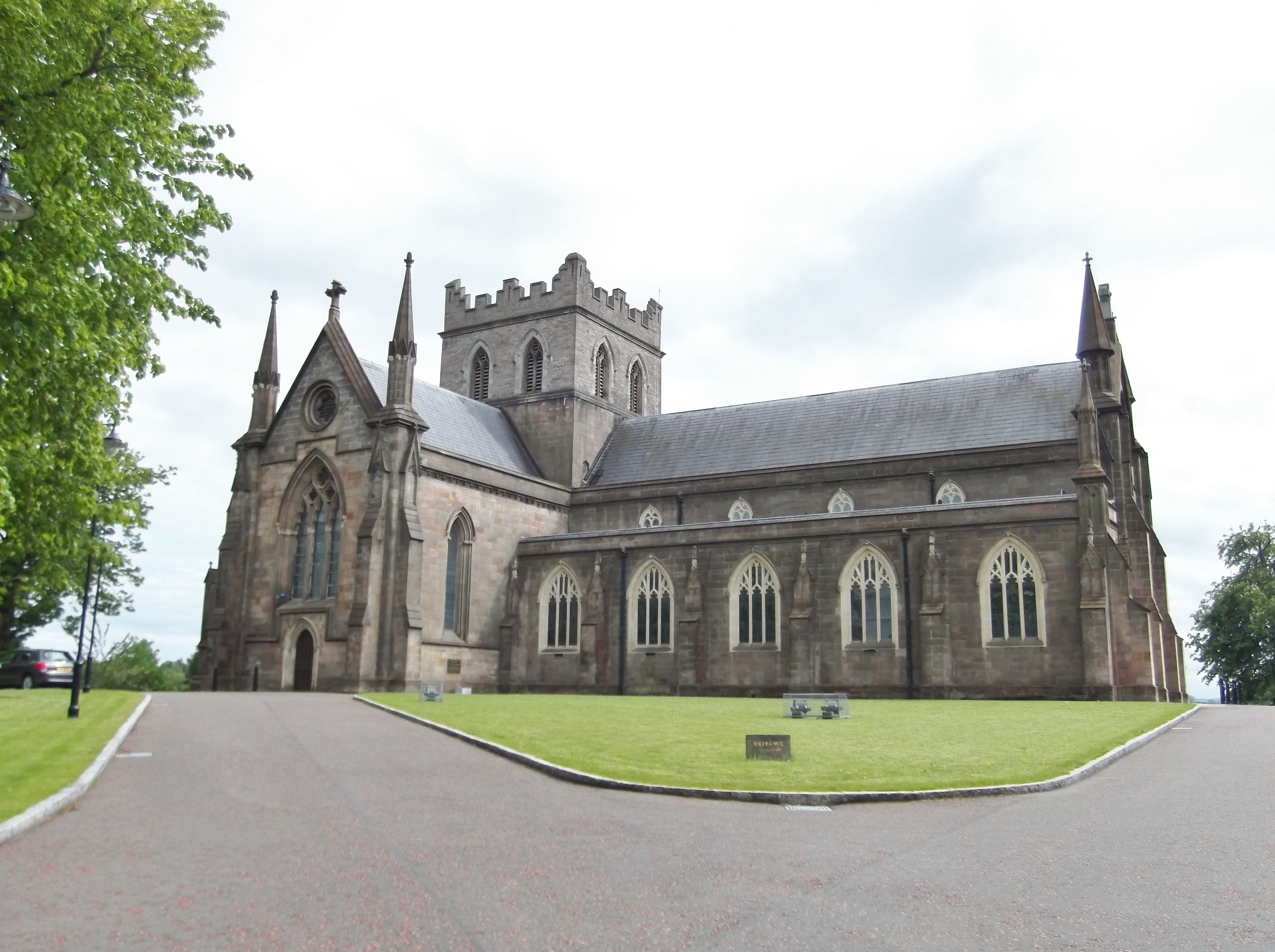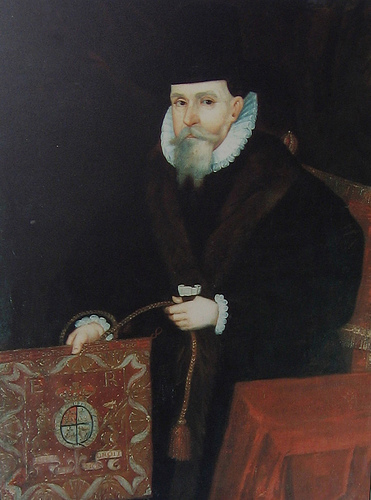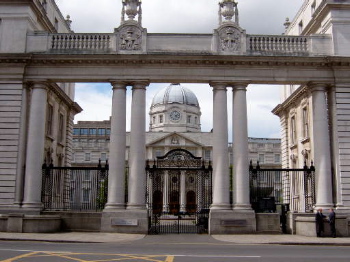|
Cardinal John D'Alton
John Francis Cardinal D'Alton (11 October 1882 – 1 February 1963) was an Irish Cardinal of the Roman Catholic Church who served as Archbishop of Armagh and thus Primate of All Ireland from 1946 until his death. He was elevated to the cardinalate in 1953. Early life and education John D'Alton was born in Claremorris, County Mayo, to Joseph D'Alton (d. 1 April 1883) and his wife Mary Brennan, at the height of the Land Wars in Ireland. He was baptised four days later, on 15 October 1882, with Michael and Mary Brennan acting as his godparents. D'Alton's mother had a daughter, Mollie Brennan, from a previous marriage; she remarried again after the Cardinal's father died in 1883. He obtained an extensive education at Blackrock College, Holy Cross College in Clonliffe, the University College Dublin, Irish College in Rome. He was a contemporary of Éamon de Valera, whom he befriended at Blackrock College. In his first year in Blackrock, de Valera beat D'Alton in two subjects – ... [...More Info...] [...Related Items...] OR: [Wikipedia] [Google] [Baidu] |
His Eminence
His Eminence (abbreviation H.Em. or HE) is a style (manner of address), style of reference for high nobility, still in use in various religious contexts. Catholicism The style remains in use as the official style or standard form of address in reference to a cardinal (Catholicism), cardinal of the Catholic Church, reflecting his status as a Prince of the Church. A longer, and more formal, title is "His [or Your when addressing the cardinal directly] Most Reverend Eminence". Patriarchs of Eastern Catholic Churches who are also cardinals may be addressed as "His Eminence" or by the style particular to Catholic patriarchs, His Beatitude. When the Grand master (order), Grand Master of the Sovereign Military Order of Malta, the head of state of their sovereign territorial state comprising the island of Malta until 1797, who had already been made a Reichsfürst (i.e., prince of the Holy Roman Empire) in 1607, became (in terms of honorary order of precedence, not in the actual churc ... [...More Info...] [...Related Items...] OR: [Wikipedia] [Google] [Baidu] |
List Of Roman Catholic Archbishops Of Armagh
The Archbishop of Armagh is an archiepiscopal title which takes its name from the see city of Armagh in Northern Ireland. Since the Reformation, there have been parallel apostolic successions to the title: one in the Catholic Church and the other in the Church of Ireland. The archbishop of each denomination also holds the title of Primate of All Ireland. In the Church of Ireland, the archbishop is John McDowell, who is the ecclesiastical head of the Church of Ireland and the diocesan bishop of the Diocese of Armagh. He was elected as archbishop in March 2020 and translated to the role on 28 April 2020. In the Catholic Church, the archbishop is Eamon Martin, who is the ecclesiastical head of the Catholic Church in Ireland, metropolitan of the Province of Armagh and the ordinary of the Archdiocese of Armagh. He succeeded on 8 September 2014, having been ordained Coadjutor Archbishop of Armagh on 21 April 2013 at St Patrick's Cathedral, Armagh. History In the medieval Irish ... [...More Info...] [...Related Items...] OR: [Wikipedia] [Google] [Baidu] |
Archdiocese Of Dublin
The Archbishop of Dublin () is an archiepiscopal title which takes its name from Dublin, Ireland. Since the Reformation, there have been parallel apostolic successions to the title: one in the Catholic Church and the other in the Church of Ireland. The archbishop of each denomination also holds the title of Primate of Ireland. History The diocese of Dublin was formally established by Sigtrygg (Sitric) Silkbeard, King of Dublin in 1028, . ''Diocese of Dublin and Glendalough''. Retrieved on 31 March 2010. and the first bishop, Dúnán, was consecrated in about the same year. The diocese of Dublin was subject to the |
Holy Orders
In certain Christian denominations, holy orders are the ordination, ordained ministries of bishop, priest (presbyter), and deacon, and the sacrament or rite by which candidates are ordained to those orders. Churches recognizing these orders include the Catholic Church, the Eastern Orthodoxy, Eastern Orthodox (ιερωσύνη [''hierōsynē''], ιεράτευμα [''hierateuma''], Священство [''Svyashchenstvo'']), Oriental Orthodoxy, Oriental Orthodox, Anglican, Assyrian Church of the East, Assyrian, Old Catholic, Independent Catholic churches, Independent Catholic and some Lutheran churches. Except for some Lutherans and some Anglicans, these churches regard ordination as a sacrament (the ''sacramentum ordinis''). Christian denomination, Denominations have varied conceptions of holy orders. In some Lutheran and Anglican churches the traditional orders of bishop, priest and deacon are bestowed using ordination rites contained within ordinal (liturgy), ordinals. The exten ... [...More Info...] [...Related Items...] OR: [Wikipedia] [Google] [Baidu] |
Donegal Democrat
The ''Donegal Democrat'' is a twice-weekly local newspaper, covering County Donegal, Ireland. The paper was traditionally based in the town of Ballyshannon in the south of the county, but now has offices in Donegal Town (southern edition) and Letterkenny (northern edition). The ''Donegal Democrat'' is the largest paper focused solely on County Donegal, and its current managing editor is Chris Ashmore. The paper was the only one published in south Donegal from the mid-twentieth century on, and so has gained a reputation of being the local paper of record for that part of the county. Since its launch, the ''Donegal Democrat'' has been published weekly on a Thursday in broadsheet format, and in recent years has become part of a chain of titles that are published three times per week in the county. The paper is now almost entirely integrated with the '' Donegal People's Press'', a paper published on Tuesdays in a compact format. The ''People's Press'' was traditionally a north Doneg ... [...More Info...] [...Related Items...] OR: [Wikipedia] [Google] [Baidu] |
Ballyshannon
Ballyshannon () is a town in County Donegal, Republic of Ireland, Ireland. It is located at the southern end of the county where the N3 road (Ireland), N3 from Dublin ends and the N15 road (Ireland), N15 crosses the River Erne. The town was incorporated in the early 17th century, receiving a town charter in March 1613. Location Ballyshannon, which means "the mouth of Seannach's Ford (crossing), ford", after a fifth-century warrior, Seannach, who was reputedly slain there, lies at the mouth of the river Erne. Just west of the town, the Erne widens and its waters meander over a long sandy estuary. The northern bank of the river rises steeply away from the riverbank, while the southern bank is flat with a small cliff that runs parallel to the river. The town looks out over the estuary and has views of mountains, lakes and forests. History Archaeological sites dating as far back as the Neolithic British Isles, Neolithic period (4000 BC – 2500 BC) have been excavated in Ballyshann ... [...More Info...] [...Related Items...] OR: [Wikipedia] [Google] [Baidu] |
Éamon De Valera
Éamon de Valera (; ; first registered as George de Valero; changed some time before 1901 to Edward de Valera; 14 October 1882 – 29 August 1975) was an American-born Irish statesman and political leader. He served as the 3rd President of Ireland from 1959 to 1973, and several terms as the Taoiseach. He had a leading role in introducing the Constitution of Ireland in 1937, and was a dominant figure in Irish politics from the early 1930s to the late 1960s, when he served terms as both the head of government and head of state. De Valera was a commandant of the Irish Volunteers (Third Battalion) at Boland's Mill during the Easter Rising, 1916 Easter Rising. He was arrested and sentenced to death, but released for a variety of reasons, including his American citizenship and the public response to the British execution of Rising leaders. He returned to Ireland after being jailed in England and became one of the leading political figures of the Irish War of Independence, War of Inde ... [...More Info...] [...Related Items...] OR: [Wikipedia] [Google] [Baidu] |
Irish College
Irish Colleges is the collective name used for approximately 34 centres of education for Irish Catholic clergy and lay people opened on continental Europe in the 16th, 17th and 18th centuries. History The Colleges were set up to educate Roman Catholics from Ireland in their own religion following the takeover of the country by the Protestant English state in the Tudor conquest of Ireland. Irish Catholics also left the country to pursue military careers in the Flight of the Wild Geese. The first Irish Colleges were established in Spain in the 1580s under the supervision of the Jesuit priest James Archer, in Salamanca and Madrid . There were several early Irish Colleges in Southern Netherlands. St. Patrick Irish college of Douai was founded in 1603 by Christopher Cusack,Fr. Christopher Cusack by Patrick M. Geogheg ... [...More Info...] [...Related Items...] OR: [Wikipedia] [Google] [Baidu] |
University College Dublin
University College Dublin (), commonly referred to as UCD, is a public research university in Dublin, Ireland, and a collegiate university, member institution of the National University of Ireland. With 38,417 students, it is Ireland's largest university. UCD originates in a body founded in 1854, which opened as the Catholic University of Ireland on the feast of Saint Malachy, St. Malachy with John Henry Newman as its first rector; it re-formed in 1880 and chartered in its own right in 1908. The Universities Act, 1997 renamed the constituent university as the "National University of Ireland, Dublin", and a ministerial order of 1998 renamed the institution as "University College Dublin – National University of Ireland, Dublin". Originally located at St Stephen's Green and National Concert Hall, Earlsfort terrace in Dublin's city centre, all faculties later relocated to a campus at Belfield, Dublin, Belfield, six kilometres to the south of the city centre. In 1991, it purchas ... [...More Info...] [...Related Items...] OR: [Wikipedia] [Google] [Baidu] |
Clonliffe
Clonliffe () is an area on the Northside, Dublin, Northside of Dublin, Republic of Ireland, Ireland, between Ballybough and Drumcondra, Dublin, Drumcondra in the Dublin 3 postal district. Location Clonliffe Road, previously known as Fortick's Lane, is a wide thoroughfare that forms the central artery of the area. It is nearly a mile in length. Near the area's border with Drumcondra there is an entrance to Holy Cross College (Dublin), Holy Cross College, and to the grounds of the residence of the Archbishop of Dublin (Roman Catholic), Archbishop of Dublin. The main access to Croke Park Gaelic Athletic Association, GAA sports ground is from Jones Road, the principal turn-off on the south side of Clonliffe Road. The historical area of Clonliffe was bounded by the River Tolka, down to the North Circular Road (possibly as far South as Aldborough House). History Clonliffe as a named townland is mentioned in 1192, and the name is thought to mean "herb meadow" or from "the plain ... [...More Info...] [...Related Items...] OR: [Wikipedia] [Google] [Baidu] |
Holy Cross College (Dublin)
Holy Cross College (also known as Clonliffe College), located on Clonliffe Road, Drumcondra, Dublin, Drumcondra, was founded in 1854 as the Catholic diocesan seminary for Dublin by Paul Cullen (cardinal), Paul Cullen, Archbishop of Dublin (Catholic Church), Archbishop of Dublin (later created, in 1866, a Cardinal (Catholic Church), cardinal). History The College was founded in 1859 by Paul Cullen (cardinal), Paul Cullen, Archbishop of Dublin (Catholic Church), Archbishop of Dublin, to provide priests for the Archdiocese of Dublin (Cullen became Cardinal (Catholic Church), Cardinal Cullen in 1866). In 1861, the Rector of the Catholic University of Ireland, Bartholomew Woodlock, tried to secure land in Clonliffe west to build a new Catholic University; however, this plan was shelved due to the expansion of the railway line. Plans were drawn up by the architect James Joseph McCarthy for the proposed new University, McCarthy designed the college building. Following the University ... [...More Info...] [...Related Items...] OR: [Wikipedia] [Google] [Baidu] |
Blackrock College
Blackrock College () is a voluntary day and boarding Catholic secondary school for boys aged 13–18, in Williamstown, Blackrock, County Dublin, Ireland. It was founded by French missionary Jules Leman in 1860 as a school and later became also a civil service training centre. The college, from Dublin city centre, is just in from the sea, and is self-contained, with boarding and teaching facilities in 56 acres of parkland. It accommodates approximately 1,000 day and boarding students. As of 2023, Blackrock is run by the Congregation of the Holy Ghost in close co-operation with a dedicated group of lay personnel. History The college was founded in 1860 by Jules Leman, a French missionary with the Congregation of the Holy Ghost, and was the first of the order's five schools in Ireland. Leman had a dual aim, namely to train personnel for missionary service in the Third World and to provide a first-class Roman Catholic education for Irish boys.Seán Farragher, ''Père Leman 18 ... [...More Info...] [...Related Items...] OR: [Wikipedia] [Google] [Baidu] |






